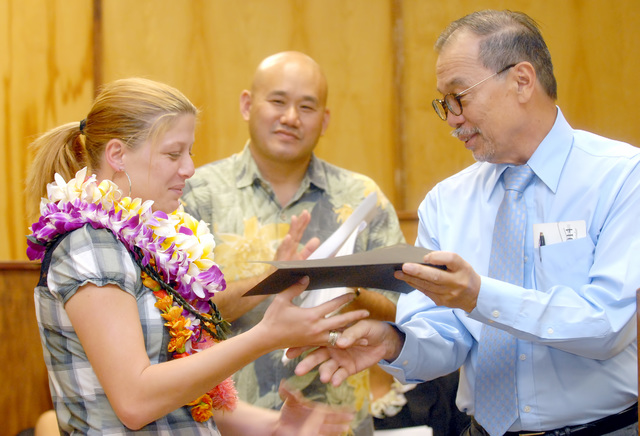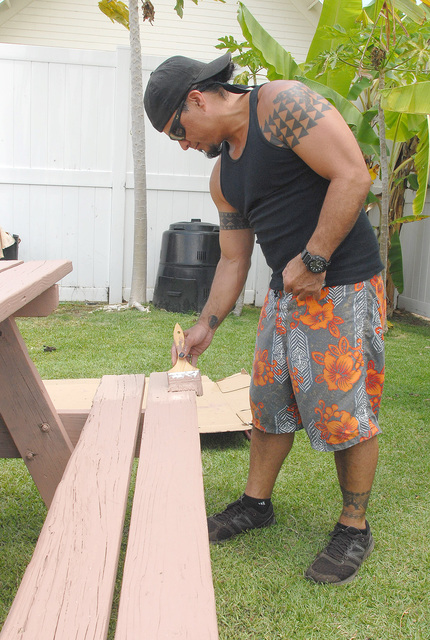Monday will mark the end of the 27 years of Judge Ronald Ibarra leading the Big Island Drug Court program.
The efforts, which Ibarra calls “training the total person,” has led to numerous turnarounds.
And it’s not just any goodbye: Ibarra is credited by state Supreme Court Justice Mark Recktenwald with bringing the program to the island in 2002 after the Honolulu program got off the ground.
A drug court is an intensive program where defendants have court-ordered counseling, testing and support to turn their lives away from chemical abuse. In exchange, the defendant may see their convictions expunged from records.
But all receive guidance on how to live improved lives.
It’s not for everyone. The entry is limited to nonviolent offenses that must be connected to drug use. One of the effective parts is using jail as an immediate sanction, Ibarra said. When someone is ordered to jail on the program, they are taken there almost immediately. This creates a clear connection between the violation and the sanction, he said.
William Skinner is set to graduate Jan. 4, after five years in the program. He was admitted on a charge of first-degree promotion of a detrimental drug. He plans to move back to the mainland with his partner and their son as soon as he’s finished, possibly taking up metal-detecting again.
Skinner is one of the two-thirds of entrants who complete the program.
“(The dropout rate is) significant, but it’s a tough program,” said Grayson Hashida, drug court coordinator, who is part of the team of probation officers, judges, law enforcement and others that work with the participants.
One of the measures in corrections is recidivism, which is what percentage of people who are arrested on a felony charge after exiting the program. The program maintains an 8-9 percent recidivism rate over three years, Hashida said. Nationwide, 67.8 percent of inmates are rearrested within that time frame, according to federal statistics.
Ibarra credits that with the efforts of the drug court team, strong requirements and immediate sanctions.
The people involved have a number of limits beyond that of general probationers. They cannot go to certain areas of the island without permission, primarily those associated with prior drug use. They can’t associate with the people who supported their drug-using lifestyle.
The most difficult, Ibarra said, is acquiring stable housing. That’s largely a result of the high cost of living on the island, he said.
The people involved also have to remain clean of drugs, earn a high school diploma or equivalent, make all court-ordered payments and go through a drug counseling program. If people violate any of the rules, they know jail is an immediate option.
The goal is “getting a life back where it was,” Ibarra said.
At times that requires convincing a participant to remain in the program.
Michael Monidelli, 44, no permanent address, was about ready to quit at his hearing on Dec. 14. He was ready to take five years in prison after admitting to multiple violations.
Monidelli, wearing prison orange and steel chains, spoke from behind a podium.
Ibarra leaned forward from the bench, listening with intent on what Monidelli was saying.
He had left a rehabilitation program without permission, gone to a prohibited area and admitted to using drugs multiple times.
Ibarra asked what had led him to do that.
Monidelli said it was because he felt persecuted by the drug rehabilitation program he was in.
He felt the staff were creating new rules expressly targeting him. Finally he had enough, he said, and left for Hilo. He said he regretted the decision, returned, and began cooking in his room. The staff met him there and removed him from the program, citing the departure and other violations.
He left and headed to Alii Drive where he drank alcohol, used marijuana and meth, he told the court.
“I’m tired of going in and out,” he said. “It’s not even about the drugs any more.”
Ibarra, rather than instantly accepting the plea, spoke with Monidelli.
“If you go five years now and you don’t get help for your drug addiction, what will you do?” the judge asked.
Monidelli did not have an answer, but explained “they just kept coming up with all these rules.”
“If it’s not about the drugs, why did you go back to using drugs?” Ibarra asked.
“It’s just what I do,” Monidelli said.
The two continued talking about Monidelli’s previous successes in the program and how to prevent another violation. Ibarra learned Monidelli had never expressed his frustration to anyone, including his probation officer.
The officers are more like case managers in the program, Ibarra said, so it’s important to express opinions to them.
Ibarra said that if Monidelli had talked about it, perhaps the problem could have been avoided. Monidelli tried to explain the difficulties and became more emotional as the conversation continued.
“I want to do good, but I can’t do it with people messing with me,” he said, striking the podium with his hand.
After some more discussion, Monidelli agreed to remain in the program, including 30 days of jail and entry into another drug rehabilitation program.
The program does more than help the person involved, said Hashida, it helps the community.
After all, when a person leaves prison they return home and “they could be your neighbors soon.” That can be a scary thought if the person does not complete a program, he said.
This can often be a time where someone’s family comes in and helps them out, Ibarra said.
Before entering the program the participants were so focused on “feeding the habit” they have often stolen from their families or abused their trust, Ibarra said.
But with the court providing structure, families are willing to risk supporting the person again, Ibarra said.
He views it as a counterpoint to what he saw as a deputy prosecutor in 1989.
Many of the judgments felt like they were solely to punish the person involved, rather than helpful for the community, he said.
“It was like a revolving door,” he said.
The new lead judge will be newly sworn-in Circuit Court Judge Melvin Fujino, who has already been hearing cases. Criticism of alternative programs is they have been a way to avoid punishments. There are some times that people will attempt to join the program as a way to avoid prison, Ibarra said.
It was more common in the beginning he said, but now that people know how tough it is and the team has grown more skilled at identifying problems, those people rarely enter.
He stressed that drug court is part of the solution, not a replacement for the traditional justice system.
Graduating participants Gregory Corrado had his final hearing on Dec. 14.
He was asked by Ibarra what advice to give to participants and the Drug Court.
“You don’t get so many opportunities where people will pay this much attention,” he said.









